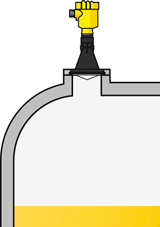Sensors: non-contact
Non-contact sensors come in many varieties. Two of the most common are ultrasonic and radar.
Both ultrasonic and radar sensors work by sending out a pulse from their location in the roof of the tank, which reflects off the surface of the product. Ultrasonic sensors, as the name suggests, emit a barely audible 'click', while a radar sensor sends out a very short burst of microwaves. The time taken for the echo to return gives a measure of the distance to the surface of the product from the gauge. This in turn can be used to calculate the volume of product in the tank.
Ultrasonic and radar gauges are popular not least because they have no wearable parts and can be very accurate.

A Vegapuls 61 radar sensor mounted on top of a tank. A cable runs from the unit to a HyDip device located nearby to send readings to an online account on your laptop.
Other considerations
Unlike a hydrostatic pressure gauge which measure pressure, these gauges measure distance.
As such, they gauges will 'see' the variation in height as a product expands and contracts with temperature. This means you will typically notice a small daily swing in your measurements if your tank is exposed to ambient temperature.
While an ultrasonic unit may be more affordable than radar, they have some limitations:
- It is not suitable if you're measuring at temperatures over 150° C, or pressures above 40 bar, due to the sound pulse being affected by factors like air density (radar is less affected).
- Ultrasonic sensors also lose reliability over greater distances (e.g. above 10m), since the pulse spreads out in a cone shape which starts to bounce off the sides of the tank and other obstacles.
- After they've emitted a sound pulse ultrasonic sensors may also need a period of time to stop vibrating before they're ready to receive the echo. This results in a longer 'dead band' than radar when measuring very short distances near to the top of the sensor.
A radar sensor, meanwhile, can work in especially varied conditions.
Ultrasonic sensors do, however, have one big advantage over radar: they can be used with liquids with a low dielectric constant, such as diesel, which can appear almost transparent to radar but reflect sound without issue.
Updated 10 months ago
